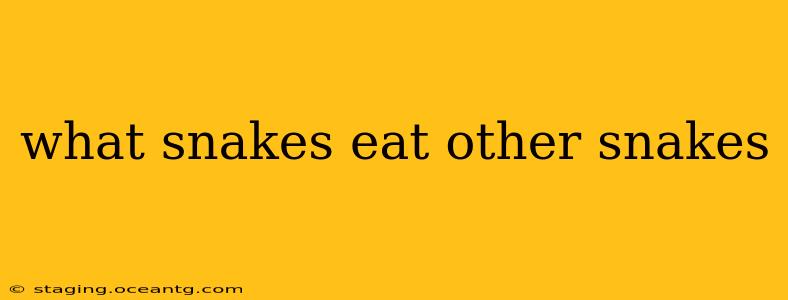Snakes eating other snakes, a phenomenon known as ophiophagy, is a fascinating aspect of the natural world. While not all snakes are ophiophagous, a surprisingly large number include other snakes in their diet. This behavior plays a significant role in maintaining the balance of snake populations within their ecosystems. This article will delve into the specifics of which snakes are ophiophagous, their hunting strategies, and the ecological implications of this predatory behavior.
What Types of Snakes Eat Other Snakes?
Many snake species engage in ophiophagy, but some are more dedicated to it than others. The propensity for eating other snakes often depends on the size and species of both the predator and the prey. Here are some examples:
-
King Snakes (Lampropeltis): Famous for their impressive prey-handling skills, king snakes are arguably the most well-known ophiophagous species. They're known to consume venomous snakes, including rattlesnakes and copperheads, demonstrating remarkable resistance to their venom.
-
Hognose Snakes (Heterodon): While primarily feeding on amphibians and other small creatures, some hognose snakes will opportunistically consume other snakes, especially if the opportunity presents itself.
-
Rat Snakes (Pantherophis): Certain rat snake species, particularly larger individuals, may incorporate other snakes into their diet, but it's not a consistent or primary food source for them.
-
Eastern Indigo Snakes (Drymarchon couperi): These large, non-venomous snakes are apex predators and will readily consume other snakes, including venomous species.
-
Many Colubrid Species: The Colubridae family is incredibly diverse, and many species within it are known to engage in ophiophagy to varying degrees.
It’s important to note that the diet of a snake can vary depending on factors like availability of preferred prey, age, and size. A snake might occasionally eat another snake if it's readily available but might primarily feed on other prey items.
How Do Ophiophagous Snakes Hunt and Kill Their Prey?
The hunting strategies of ophiophagous snakes are varied and often depend on the size and temperament of both predator and prey. Some common techniques include:
-
Constriction: Larger snakes, like king snakes and rat snakes, might subdue their prey by constriction, wrapping their bodies around the other snake to restrict its breathing and blood flow.
-
Venom: While less common in ophiophagous snakes, some venomous species will use their venom to immobilize or kill their prey before consuming it.
-
Ambush: Many ophiophagous snakes utilize ambush tactics, waiting patiently for an unsuspecting snake to come within striking distance before attacking.
-
Overpowering: Sometimes, sheer strength and size are enough. A larger snake might simply overpower and subdue a smaller one.
Are There Any Specific Venomous Snakes that Eat Other Snakes?
Yes, several venomous snakes are known to eat other snakes. Examples include some species of coral snakes and certain rattlesnakes, though their diets are typically more diverse and not exclusively ophiophagous. Even venomous snakes can fall prey to larger, more powerful ophiophagous snakes.
What are the Ecological Implications of Snakes Eating Other Snakes?
Ophiophagy plays a crucial role in regulating snake populations and maintaining the overall balance of the ecosystem. By preying on other snakes, ophiophagous species help to prevent any single snake species from becoming overly dominant. This, in turn, helps to maintain biodiversity and prevent imbalances within the food web.
Do all snakes eat other snakes?
No, not all snakes eat other snakes. Many snake species have diets consisting primarily of rodents, amphibians, birds, eggs, or insects. Ophiophagy is a specialized dietary adaptation present in only a subset of snake species.
In conclusion, the world of ophiophagy is complex and fascinating, highlighting the intricate relationships within snake populations and their broader ecological roles. Understanding these predatory interactions is crucial for appreciating the remarkable diversity and adaptability of snakes within their environments.
